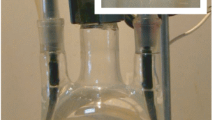Abstract
Analysis of the plasma emission from a low-pressure microwave cavity discharge through flowing hydrogen peroxide vapor showed that both H and OH were produced in proportions which varied with the applied power. When the dissociated vapor was condensed at 195 K only water was obtained; at 77 K, H2O2 and H2O4 were also obtained. Their formation could not be increased by increasing the H atom or OH radical concentration in the plasma. When the reaction time of the dissociated vapor between the plasma exit and the cold surface was increased, the rate of H2O2 formation increased mostly at the expense of water formation. It appears that, as in the case of the reaction of H with O2, the rate of H2O2 formation is dependent on the concentration of O2 produced in the spatial afterglow by the gas-phase reactions of the hydroxyl radicals.
Similar content being viewed by others
References
M. Venugopalan and R. A. Jones,Chem. Rev. 66, 133 (1966).
M. Venugopalan and R. A. Jones,Chemistry of Dissociated Water Vapor and Related Systems (Wiley-Interscience, New York, 1968), Chapter 3.
H. C. Urey, L. H. Dawsey, and F. O. Rice,J. Am. Chem. Soc. 51, 1371 (1929).
A. A. Frost and O. Oldenberg,J. Chem. Phys. 4, 781 (1936).
S. N. Foner and R. L. Hudson,J. Chem. Phys. 23, 1964 (1955);36, 2681 (1962).
R. L. Allen and F. S. Stone,Nature (London) 180, 752 (1952).
J. S. Batzold, C. Luner, and C. A. Winkler,Can. J. Chem. 31, 262 (1953).
A. I. Gorbanev, A. B. Tsentsiper, I. M. Ziteneva, and M. S. Danilova,Izv. Sibirsk. Otdel. Akad. Nauk SSSR, 43 (1958).
A. A. Westenberg and N. de Haas,J. Chem. Phys. 58, 4066 (1973).
R. A. Jones, W. Chan, and M. Venugopalan,J. Chem. Phys. 51, 1273 (1969).
N. Hata and P. A. Giguiere,Can. J. Chem. 44, 869 (1966).
R. A. Jones and M. Venugopalan,Can. J. Chem. 45, 2452 (1967).
M. Venugopalan and K. Choi,Z. Phys. Chem. 74, 32 (1971).
R. A. Jones, W. Chan, and M. Venugopalan,J. Phys. Chem. 73, 3693 (1969).
K. F. Bonhoeffer and T. G. Pearson,Z. Phys. Chem. Abt. B 14, 1 (1931).
T. M. Sanders, Jr., A. L. Schawlow, G. C. Dousmanis, and C. H. Townes,J. Chem. Phys. 22, 245 (1954).
S. N. Foner and R. L. Hudson,Adv. Chem. Ser. 36, 34 (1962).
C. J. Hochanadel, T. J. Sworski, and P. J. Ogren,J. Phys. Chem. 84, 3274 (1980).
R. F. Hampson, Jr., and D. Garvin,Nat. Bur. Stand. Spec. Publ. (U.S.) No. 513 (1978).
F. Kaufman,Ann. Geophys. 20, 106 (1964);Can. J. Chem. 47, 1917 (1969).
Author information
Authors and Affiliations
Rights and permissions
About this article
Cite this article
Venugopalan, M., Shih, AL. Reactions of hydrogen peroxide vapor dissociated in a microwave plasma. Plasma Chem Plasma Process 1, 191–200 (1981). https://doi.org/10.1007/BF00564580
Received:
Revised:
Issue Date:
DOI: https://doi.org/10.1007/BF00564580



